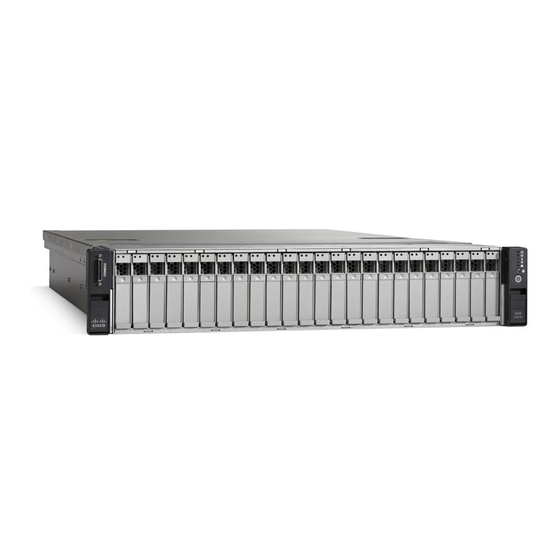Cisco UCS C240 Kurulum Kılavuzu - Sayfa 14
Sunucu Cisco UCS C240 için çevrimiçi göz atın veya pdf Kurulum Kılavuzu indirin. Cisco UCS C240 22 sayfaları. Connected safety and security (css)
Ayrıca Cisco UCS C240 için: Kullanıcı Kılavuzu (22 sayfalar)

NIC Modes and NIC Redundancy Settings
NIC Modes and NIC Redundancy Settings
This server has the following NIC mode settings that you can choose from:
•
•
•
•
Note
This server has the following NIC redundancy settings that you can choose from:
•
•
•
Cisco UCS C240 Server Installation and Service Guide
2-14
Shared LOM EXT (default)—This is shared LOM extended mode. This is the factory-default
setting, along with Active-active NIC redundancy and DHCP-enabled. With this mode, the shared
LOM and Cisco Card interfaces are both enabled.
In this mode, DHCP replies are returned to both the shared LOM ports and the Cisco card ports. If
the system determines that the Cisco card connection is not getting its IP address from a Cisco UCS
Manager system because the server is in standalone mode, further DHCP requests from the Cisco
card are disabled. If the system determines that the Cisco card connection is getting its IP address
from a Cisco UCS Manager system, the reply has parameters that automatically move the server to
UCSM mode.
Dedicated—The dedicated management port is used to access the CIMC. You must select a NIC
redundancy and IP setting.
Shared LOM—The 1-Gb Ethernet ports are used to access the CIMC. You must select a NIC
redundancy and IP setting.
Cisco Card—The ports on an installed Cisco UCS virtual interface card (VIC) are used to access the
CIMC. You must select a NIC redundancy and IP setting.
The Cisco Card NIC mode is currently supported only with a Cisco UCS VIC that is installed in
PCIe slot 2. See also
Special Considerations for Cisco UCS Virtual Interface Cards, page
None—The Ethernet ports operate independently and do not fail over if there is a problem.
Active-standby—If an active Ethernet port fails, traffic fails over to a standby port.
Active-active—All Ethernet ports are utilized simultaneously.
The active/active setting uses Mode 5 or Balance-TLB (adaptive transmit load balancing). This is
channel bonding that does not require any special switch support. The outgoing traffic is distributed
according to the current load (computed relative to the speed) on each slave. Incoming traffic is
received by the current slave. If the receiving slave fails, another slave takes over the MAC address
of the failed receiving slave.
Chapter 2
Installing the Server
3-44.
OL-25761-01
